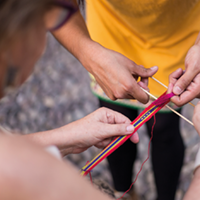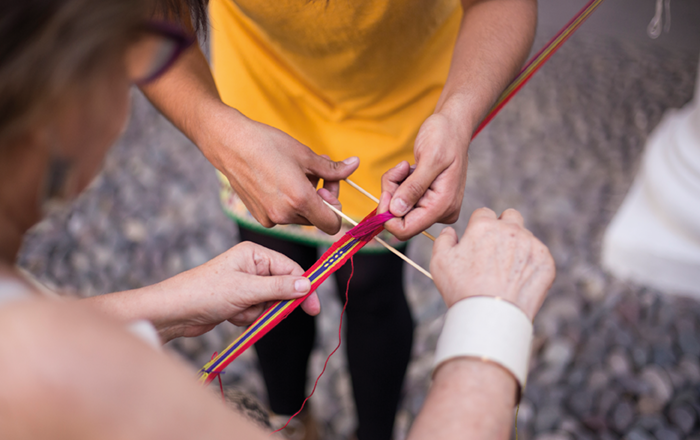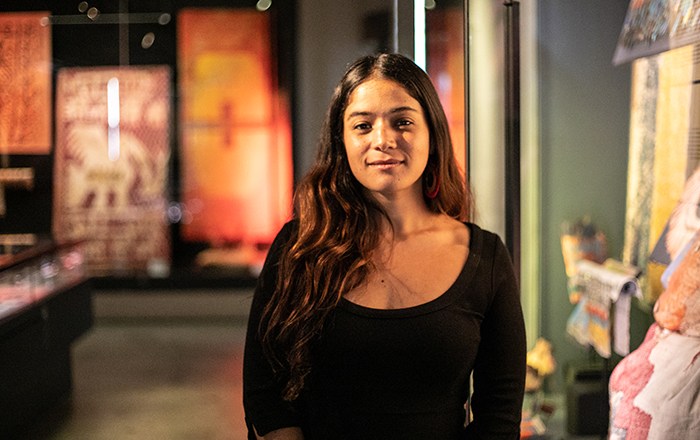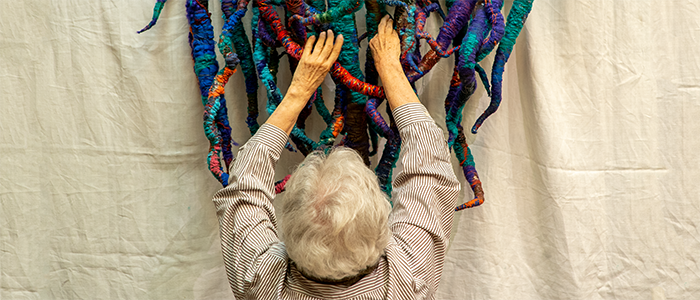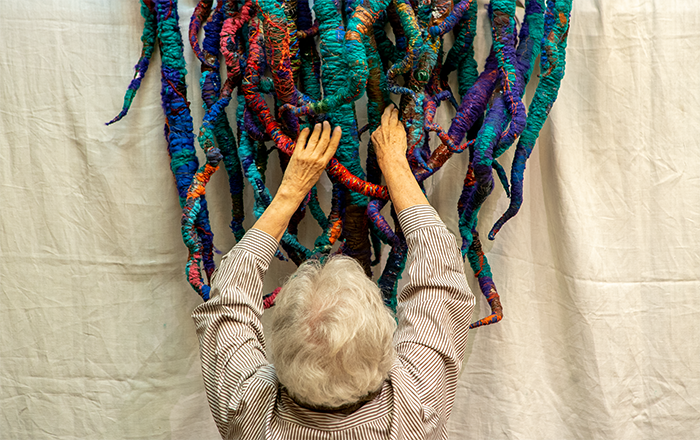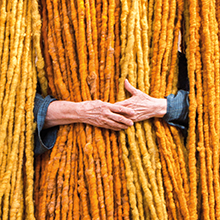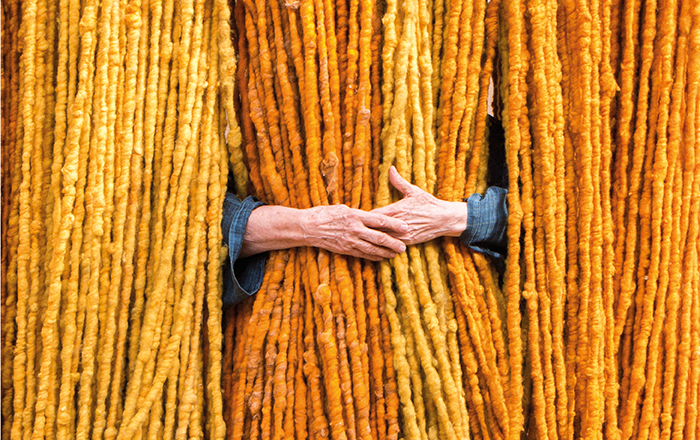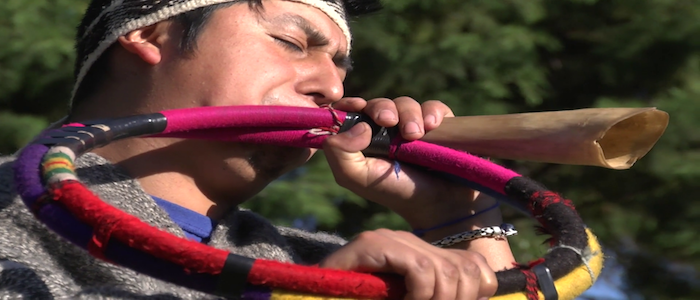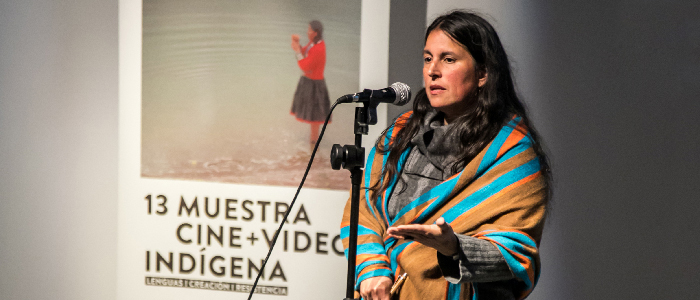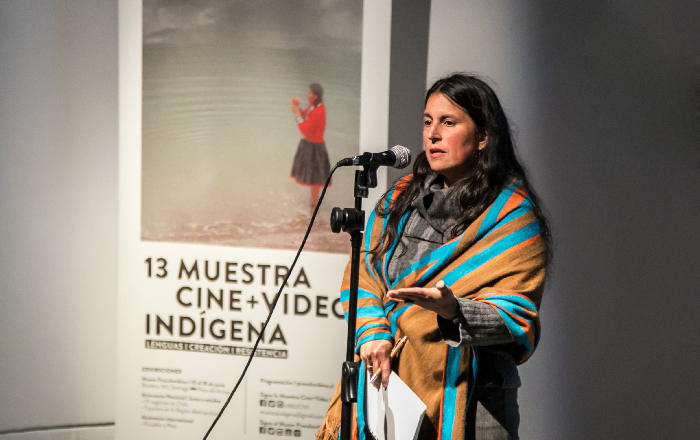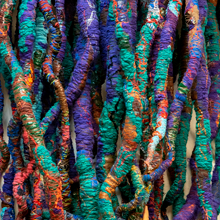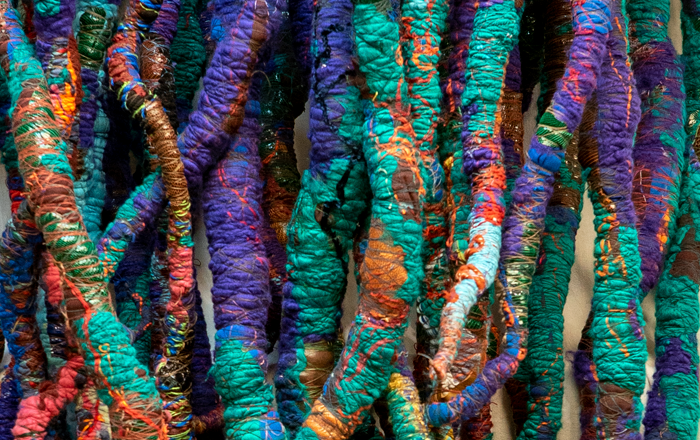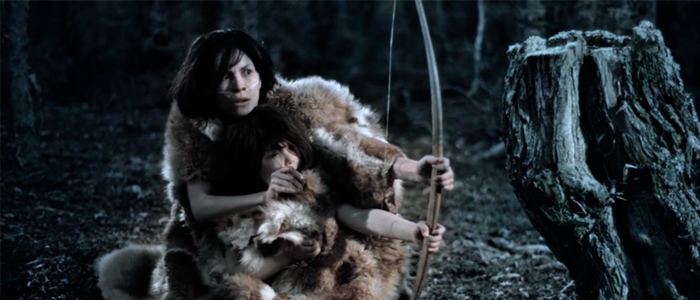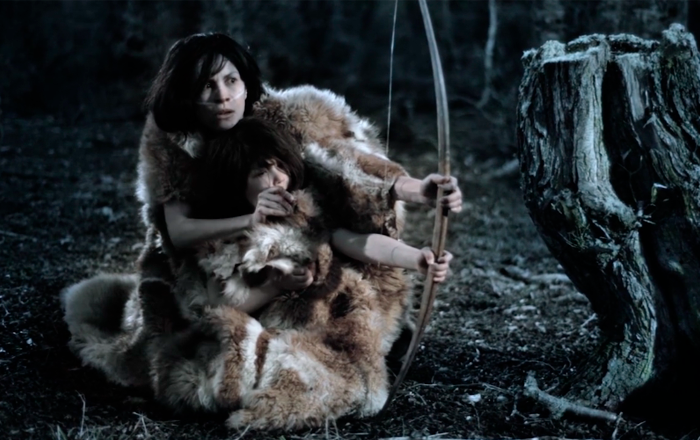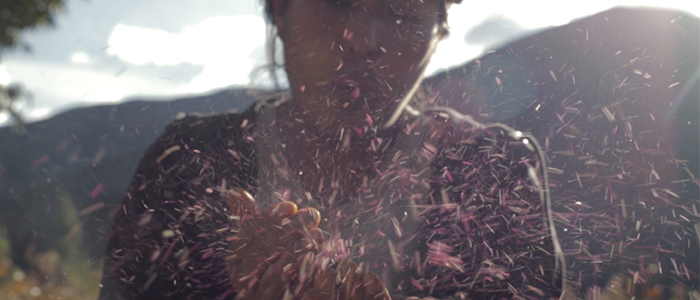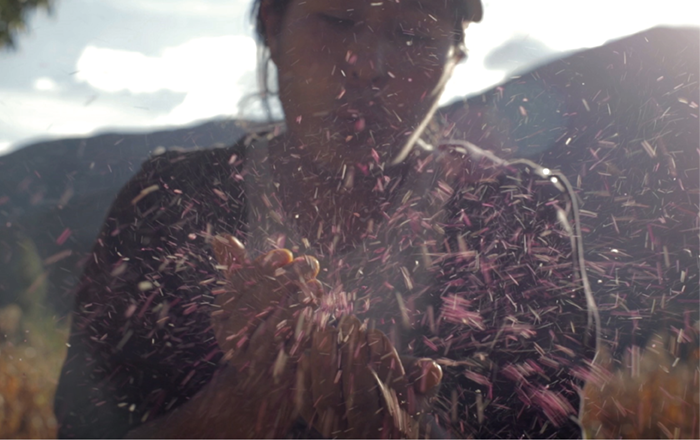Sheila Hicks smiles when she finds, intact in her memories, the names of the streets in Santiago, the walks through the Parque Forestal and the profound human dignity she found here, in South America, six decades ago.
In 1957, at 23 years of age, the young Sheila left her native United States to undertake an incredible trip, following the Andes Mountains from Venezuela to Tierra del Fuego. Then a painter, it was in Ecuador, Perú, Bolivia, and Chile where she discovered textiles, whose intelligence and simplicity impacted her to such an extent that they changed her life, and her work, forever.
Since then, Sheila Hicks’ textiles have been displayed in the most important museums and galleries in the world. Weeks from turning 85 years old, she continues working every day at her atelier, mixing distinct materials only for pleasure, the pleasure of discovery.
“All of my works are a huge game”, explains the artist, surrounded by plants, colors and fabrics on a warm afternoon in Paris. Her most recent game is the exhibition Reencuentro, curated by the Chilean researcher Carolina Arévalo, which will be on display until January 2020 at the Museo Chileno de Arte Precolombino.
Your first impression of Santiago in 1957 was of a grey and crowded city, in comparison with the beautiful villages and places you had previously seen on your trip down the Andes. What are your memories of the city and your expectations for this reunion?
You are asking me about things that happened in 1957. Imagine that. I have to try to remember what I thought—Sheila pauses, silently, for a few seconds and then continues—. Calle Huérfanos. That scared me. The office where I had to go to notify that I had arrived in Chile was on Calle Huérfanos. I got my mail on that street for five months and it was shocking to me, it wasn’t poetic, it was a little sad. Huérfanos! Imagine that. After that I lived on Calle Merced, near the Parque Forestal. That was much happier. Better than Huérfanos, right?—she laughs—. Leaving from this little house on Merced was the Parque Forestal, which was for me a spectacular garden, very beautiful. Is it still beautiful, do people still go there a lot? Is it still open or did they put a wall around it?
It’s still beautiful, open and very popular.
That’s fantastic. On Calle Merced I had a little balcony with a very large window. I opened the window and had the Parque Forestal as a garden. To be able to have the park right in front of my door was incredible. Then, my impression of Santiago improved every day.
How were those first days in Santiago?
In the beginning I didn’t have any furniture. I went to a store that has its stock on sale and asked them to sell me a bed. For a while, that was the only thing I had. Afterward I went to La Vega and bought two wicker chairs, because they were very lightweight and I could walk with them. I walked about twenty blocks, I could sit on the street, rest, and keep walking with my two chairs. I believe I also bought a wicker table. Since I had nothing to hang on the walls, I took all of my dresses and blouses and hung them, I made a very nice composition. So I felt accompanied, not so alone, living with my few, but essential, pieces of furniture, with my dresses hanging on the wall, which became my companions, and with the Parque Forestal in front.
Are you excited to return to your old neighborhoods, to return to see the Parque Forestal?
Very excited. When I arrived in Santiago in September of 1957, it was spring. I walked through the Parque Forestal with the German landscape architect Oscar Prager, who designed it. I remember lots of diverse plants. Little by little I came to know not only Santiago Centro, but also Providencia, a little bit of all the surroundings. There were lots of beautiful gardens. After that I went by motorcycle to Valparaíso with an architect my age, very young, about 25 years old, who invited me to see the landscape. Imagine the impression I have of Chile traveling like this. I traveled along the entire coast, I went to La Ligua, I went to Isla Navarino, do you know where that is? In the extreme South. I went there on a little boat, and I also traveled on a small plane with a group of cartographers who were making maps of the region. It was very pretty. I traveled with the photographer Sergio Larraín. His father is the founder of the Museo Precolombino, where I will exhibit, but at that time, when I was there, he was the dean of Architecture at the Universidad Católica. He met me when I arrived.
As you said, the Museo Chileno de Arte Precolombino was founded by Sergio Larraín García-Moreno, the father of Sergio Larraín Echenique, both important people on your first trip to Chile. What does it mean for you to reunite with this part of your history?
I feel delighted to be able to bring my granddaughters. They, for the first time, are going to know the country of their grandfather. The emotion is very strong. They know the folklore and they meet some Chileans who come to Paris, but they don’t know Chile. I want them to go around, to travel, to go to Chiloé, Temuco, Valdivia. I am going back in my thoughts, in my memory, my history, through them as they are so young.
The exhibition Reencuentro will have you returning to Chile after fifty years. Why did you agree to do this, and why now?
Because I dance when I am invited to dance. There were Chileans who invited me to return to Chile to do something and I loved it. I was lucky to meet Carlos Aldunate, the director of the Museo Chileno de Arte Precolombino, who was in Paris on a visit. He knew the exhibition I did two years earlier in the Museo de Puebla in Mexico, he came to my atelier and said to me, why not in Chile? And yes, why not.
Some of the pieces you created during your stay in Chile, and which you will display in Reencuentro, were named after places in the country (Zapallar Domingo, Chiloé-Chonchi, Parque Forestal, and Tacna Arica). How did the landscapes and the architecture inspire your creative practice?
In Chile it wasn’t the architecture that inspired me as much as the villages, the landscapes and the people. The way that people lived, improvising life in the field. I loved that. To see how people worked manually, producing their houses, their furniture, their dresses, their food, fishing. It impressed me a lot to see how people were independent in the sense that they knew how to build a life. In cities like Paris, New York or Chicago, people don’t know how to live without the supermarket, without all that which is separated from the little, essential, poetic things of life. When I lived in Chile, I loved seeing how people improvised every day and every night. It is fantastic because there is an individual expression, there isn’t repetition, everyone is an individual with a personality, preferences, ideals, and creative abilities.
These people or this way of doing that you found in Chile, does it continue to inspire you?
Yes. They gave me standards. When I was young, my way of judging was a little naive. The people I met helped me establish my levels of culture and the orientation of my appreciation. That, once it is established in your perception of life, follows you forever. I live in Paris, but the bases of my cultural framework are from school when I was young and from all the trips I took, making an impression on me and discovering the world with very good guides. That was my luck, to meet people in Chile who helped me form my cultural framework to this day.
In your trip through South America, what was the main thing you learned about yourself and your way of understanding art?
To begin with, I did not know what art was. I didn’t know it, I had a preconception. And when you are traveling alone you aren’t looking for art, you aren’t looking for an adventure in art. You are on the adventure of surviving. The luxury of thinking about art was impossible, my concerns were where I am going to sleep, where I am going to eat, and how I am going to protect myself. At that time I spoke hardly any Spanish, I learned later when I had more security. I was too scared to be thinking about art. When I was in college, in the School of Art we studied all the different historical cultures of the East, of Africa, European, and I do not know why the pre-Columbian culture attracted me the most. The people, the things they made, the weavings that were so simple and so complicated at once, they represented a type of dignity I admire. There is a profound human quality in the highland population. That was my impression when I was in Ecuador, Perú, Bolivia, and Chile. The highland is a silent and spiritual place that attracted me a lot, with a dignity that is rarely seen, a very deep kind of silence. There are people who talk all the time and never say anything. There are people who talk very little but you feel that they have much to say.
How was your relationship with the indigenous communities you met in South America? How did you contact them, how did you communicate?
I had the fortune of being interested in textiles, which are an international language. You do not have to say a word, you sit beside a weaver and you speak without opening your mouth. So, sitting, after fifteen minutes in a row, you are able to perceive the level of intelligence and begin to communicate with the eyes, the hands, the heart.
At some point you felt that textiles were unfairly considered a minor art, or as not even belonging in the art world. Do you believe this perception persists or in some way has it been understood that textiles are a form of art?
It is evident that the battle is won. But it’s not my fault!—she laughs, once again—. There are a lot of people who silently share my feelings. We are not yelling and begging to be accepted as artists, we are seated calmly, making, and inevitably others are discovering the infinity of speaking with lines of color and texture. When I start to build with a line, with a thread, and I begin the adventure of moving that line in space, in three dimensions, imagine where it can go. It can go very far. I am living a poem of discovering threads in the highlands, a poem that began in 1957 and never ended, a dream that continues day and night.
Do you keep making new things all the time, thinking about some exhibition?
Right now there are four people working here in my workshop, every day from nine in the morning until six in the afternoon. I do it thinking about what gives me pleasure. I want to know what will happen if I mix this and this. To discover, to play. All of my works are a huge game.
What does it mean for you to be able to show what you’ve made to massive audiences around the world?
The thing I like the most is discovering the reactions of people of different ages. When three year old kids come to my exhibitions, I love to follow them and discover how they discover. It is a miracle to see how they see, to see them impacted without discord, without intellectual process, without the need to explain or justify. I love to put my textiles in a market, or in the Parque Forestal, and let people of all ages to discover them. It doesn’t matter the national or geographic origins, humans are humans, they have eyes, fingers, feelings, attractions and repulsions. That is very basic, and as I make such basic things, there will always be something to discover. In my exhibitions, people don’t enter and say what is this, I don’t understand, something very common in contemporary art. In my exhibitions people don’t question, they only enter and say: oh lá lá!
Interview by Oriana Miranda
Photo by Cristóbal Zañartu




































